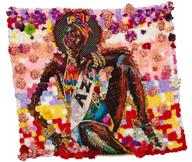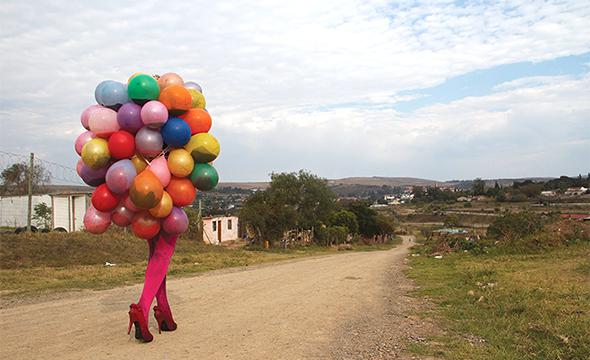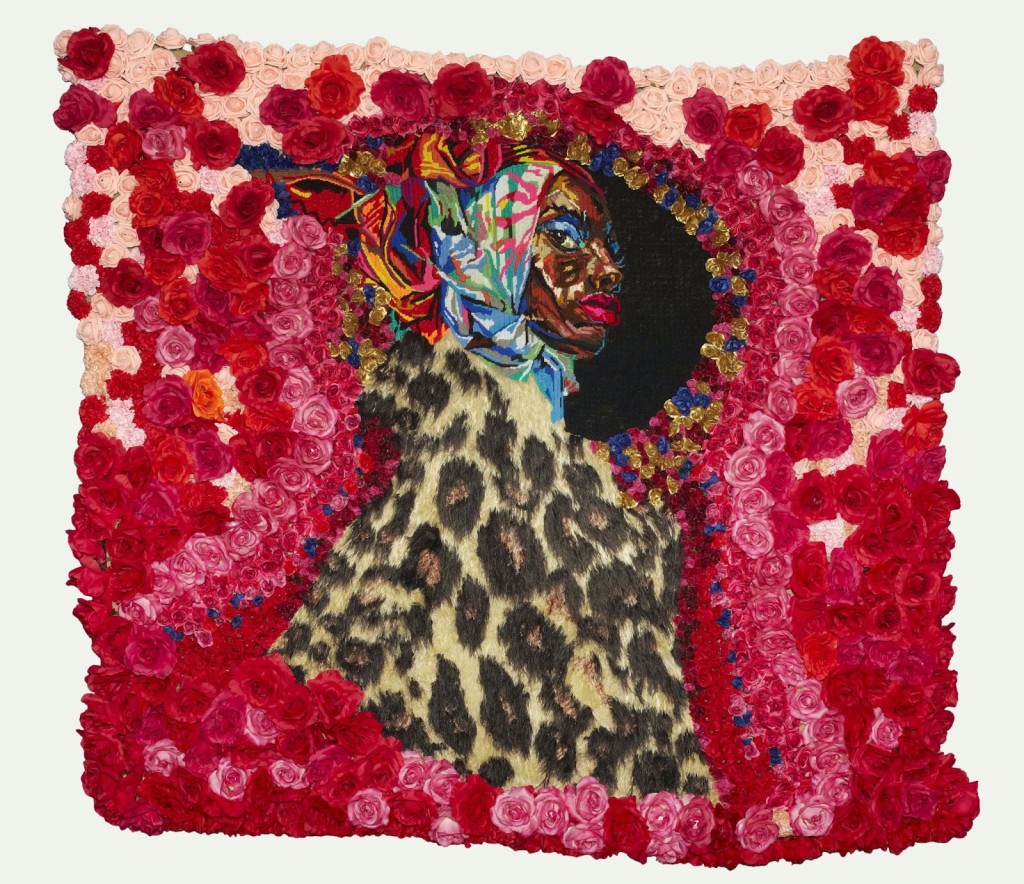
Courtesy: WHATIFTHEWORLD / GALLERY
1 Argyle Street (Corner of Argyle & Albert Road)
Woodstock 7925
Cape Town, South Africa
 The Lands of Aziana, 2013 (tapestry).
The Lands of Aziana, 2013 (tapestry).
Born Umtata, South Africa in 1984 and lives and works in both Johannesburg and Cape Town.
Exploring the border-zones between fashion, performance and contemporary art, Athi-Patra Ruga makes work that exposes and subverts the body in relation to structure, ideology and politics. Bursting with eclectic multicultural references, carnal sensuality and a dislocated undercurrent of humor, his performances, videos, costumes and photographic images create a world where cultural identity is no longer determined by geographical origins, ancestry or biological disposition, but is increasingly becoming a hybrid construct. A Utopian counter-proposal to the sad dogma of the division between mind and body, sensuality and intelligence, pop culture, craft and fine art, his works expresses the eroticism of knowledge and reconciles the dream with experience.
Recent exhibitions include: Under a Tinsel Sun the main exhibition of the III Moscow International Biennale For Young Art; Making Way, in collaboration with Mikhael Subotzky at the National Arts Festival in Grahamstown, South Africa; Ilulwane, a solo performance at PERFORMA11 (NY) as well as Infecting the City (CPT); Beauty and Pleasure in Contemporary South African Art at the Stenersen Museum in Oslo, Norway; the Guangzhou Trienalle in China; Ampersand at the Daimler Collection (Berlin); A Life Less Ordinary – Performance and Display in South African Art, (UK); For Those Who Live in It – Pop culture Politics and Strong Voices,MU (Holland); Athi-Patra Ruga – The Works, Solo Exhibition at FRED (London) and Dak’Art – Biennale of African Contemporary Art (Dakar).
Athi-Patra Ruga was also recently included in the Phaidon book ‘Younger Than Jesus’, a directory of over 500 of the world’s best artists under the age of 33. His works form part of private public and museum collections here and abroad, namely: Museion – Museum of Modern and Contemporary Art, Bolzano Italy; CAAC – Pigozzi Collection; The Wedge Collection, Iziko South African National Gallery.
Athi-Patra Ruga
The title of Athi-Patra Ruga’s recent solo exhibition, ‘The Future White Women of Azania Saga’, composed of mostly large-scale embroidered canvases and portrait photographs concretizing the mythology surrounding a series of performances the artist initiated in 2010, took me back to a day at my all-white pre-democracy high school. Politics was on the agenda: a left-leaning gay wit in class remarked that he couldn’t understand all the fuss about South Africa transforming to a black majority state named Azania, as some black nationalists were mooting. ‘At least we’ll be seated at the front of the United Nations,’ he remarked. As things transpired, South Africa remained South Africa, seated nearer the back. And Azania, that imprecisely defined utopia first pinpointed in Roman times? Well, it never materialized.
Ruga, an out gay man living in Cape Town who studied fashion illustration in Johannesburg, is not the first South African artist to immerse himself in an imaginary republic reflecting a perfectly distilled fictional state replete with the symbolic trappings of nationhood. Walter Battiss, possibly the country’s first indigene avant-gardist, came up with the cartoonish, nonsense universe of Fook Island – an ‘island of the imagination’ – in 1971. ‘You will seek in vain on maps for the location of the island, for it eludes conventional cartography,’ offered Battiss, a gifted teacher, art historian and closeted homosexual living in a state where sodomy was a criminal offence.
Like Ruga in his 2013 work The Lands of Azania (2014–2094), an embroidered map depicting the Horn of Africa (homophobic Uganda is christened ‘New Sodom’), Battiss also created maps; he even issued stamps and passports for Fook Island. There was, as there still is, though with different inflections nowadays, a serious correlative to this artistic tomfoolery. During Battiss’s time, a number of legally constituted, albeit fake, black democracies were dotted across South Africa’s political territory; Ruga was born in Umtata, formerly the capital of one of them, Transkei. Like Battiss, Ruga is no less motivated by the social context in which he operates.
In the past, Ruga’s performance work – which has the gaudy splendour of Leigh Bowery’s, even though it was decisively influenced by Tracey Rose and Sharon Bone, a notorious Johannesburg drag performance artist who starred in Stanimir Stoykov’s
gay underground films – has deployed camp pageantry to tactically comment on Swiss and South African xenophobia, as well as escalating homophobia across Africa. But these performances, and the fragmentary photographic evidence they produced, often seemed random; by comparison, ‘The Future White Women of Azania Saga’ presented an imaginative and cohesive statement, one in which humour, colour, fashion and a vivid pop sensibility have as much agency as anger, outrage and the right to say, ‘Fuck this!’
Formally, the exhibition was composed of 11 embroideries portraying Azanian dignitaries, five photographic portraits of a figure wearing a balloon dress (Ruga performed in such a garment outside the Basilica di Santa Maria Gloriosa dei Frari at the opening of the Venice Biennale last year), a sculptural tableau featuring the same balloon-clad persona standing next to a prone figure composed of artificial flowers, and a video work commissioned by Puma for the sportswear brand’s films4peace project. Ruga’s sculpture bears traces of the same formal and conceptual poverty as that of his contemporary Mary Sibande. Both seem to be rehearsing Yinka Shonibare’s sculptural practice. The plasticity and gloss of photography, in which sheen and flatness tend to iron out formal kinks, is better suited to Ruga’s and Sibande’s rich imaginative visions.
Ruga’s tapestries, however, are where he comes into his own. Incorporating cheeky riffs on expressionist painter Irma Stern, they depict a zany fictional world that purposefully reflects on the artist’s home country. Azania, as Ruga imagines it, is a sunshine state of desert landscapes ruled by a ‘pantheon of ladies’. One ruler stands out: Versatile Queen Ivy, founder of the Azanian state. Ivy, portrayed in three tapestries, has green matted hair and rides a sabre-toothed zebra; Ruga describes her as a mash-up of Lady Godiva and Rihanna. The exhibition also included an ambiguously gendered self-portrait, Uzukile the Elder (2013). Achieved in dark and sombre tones, the person it portrays is ‘not the future white woman of Azania, but a dude with a moustache, porky, not really leotard-friendly’, according to Ruga. But, as recompense, he is richly blessed with imagination.
Sean O’Toole




